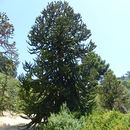Biology
provided by Arkive
The seeds are shed between March and April and germinate the following spring after dispersion (4). Falling to the base of their parent tree they are dispersed by a wide variety of animals such as birds (Enicognathus leptorhynchus), rodents (Phyllotis darwinii) and cattle (4). The seeds of the monkey puzzle constitute an important food source for the indigenous Pehuenche people, who have been collecting these protein-rich seeds for centuries (7).
Monkey puzzle trees have a number of adaptations to survive fire, and may need low levels of fire to maintain the population. Volcanic activity and fire caused by lightning are regular features of this landscape and help to maintain the forest composition by periodically removing faster growing species, such as Nothofagus pumilio (2).
Conservation
provided by Arkive
The monkey puzzle was declared a National Monument in Chile in 1976, a status that prohibits logging (4). The species is also protected in Argentina although logging pressure continues outside of National Parks (4). Conservation recommendations include the development of new protected areas in the coastal mountain range and the mapping of existing populations (7). The Global Trees Campaign is planning restoration activities for the monkey puzzle in areas of its former range (7).
Description
provided by Arkive
Monkey puzzle trees are highly distinctive, with mature trees possessing a tall, straight trunks and an umbrella of branches at the crown (4). Young monkey puzzles have a 'christmas tree' shape, with branches on the lower parts of the trunk which are later shed (5). The smooth bark is greyish-brown in colour (2) and can be up to eight centimetres thick (4). The horizontal branches emerge from the trunk in whorls of three to eight and the tree is covered in scale-like leaves all year round (4). These trees are mainly dioecious; different trees bear flowers of different sexes. The large cones develop in the upper branches (6) and bright orange-brown seeds are released (2).
Habitat
provided by Arkive
These trees cast a unique vista in the mountainous regions where they are found, their tall, straight trunks being highly unusual at altitude. They are often found in mixed forests with the deciduous Nothofagus pumilio; the taller monkey puzzle trees emerging above the canopy of these smaller natives (4).
Range
provided by Arkive
Endemic to Chile and Argentina in South America. This species is found in the Andes Mountains that separate these two countries. The range extends from 900 metres above sea level to the tree line at 1,800 metres (4). Two additional populations are found in the coastal mountain range of Chile known as the Cordillera de Nahuelbuta (4); these coastal populations are thought to be genetically distinct from the Andean trees (7).
Status
provided by Arkive
Classified as Vulnerable (VU) on the IUCN Red List 2007 (1), and listed on Appendix I of CITES (3).
Threats
provided by Arkive
The tall trunks of the monkey puzzle have been used in construction over the centuries; the wood is very resistant and has been used in buildings, shipping, and furniture (7). In the building industry it is often sold as 'Parana pine' (5). In addition, populations have declined as a result of habitat destruction and unsustainable levels of fire. During 2000 and 2001 thousands of hectares were destroyed by fire in southern Chile (7).

